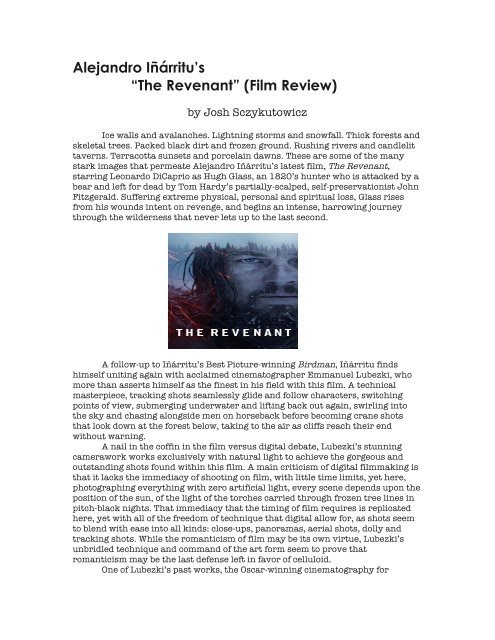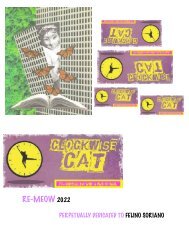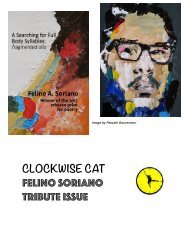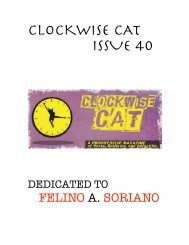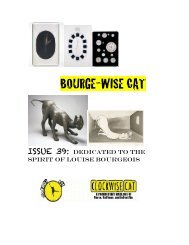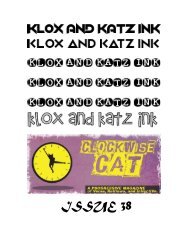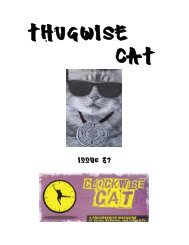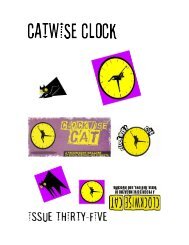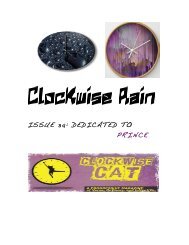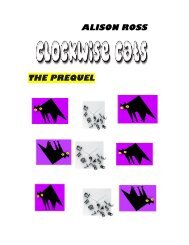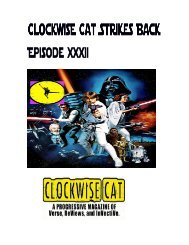StarCat/CatStar
StarCat/CatStar is dedicated to the memory of David Bowie, that cosmic subversive who’s returned at last to his ethereal home.
StarCat/CatStar is dedicated to the memory of David Bowie, that cosmic subversive who’s returned at last to his ethereal home.
You also want an ePaper? Increase the reach of your titles
YUMPU automatically turns print PDFs into web optimized ePapers that Google loves.
Alejandro Iñárritu’s<br />
“The Revenant” (Film Review)<br />
by Josh Sczykutowicz<br />
Ice walls and avalanches. Lightning storms and snowfall. Thick forests and<br />
skeletal trees. Packed black dirt and frozen ground. Rushing rivers and candlelit<br />
taverns. Terracotta sunsets and porcelain dawns. These are some of the many<br />
stark images that permeate Alejandro Iñárritu’s latest film, The Revenant,<br />
starring Leonardo DiCaprio as Hugh Glass, an 1820’s hunter who is attacked by a<br />
bear and left for dead by Tom Hardy’s partially-scalped, self-preservationist John<br />
Fitzgerald. Suffering extreme physical, personal and spiritual loss, Glass rises<br />
from his wounds intent on revenge, and begins an intense, harrowing journey<br />
through the wilderness that never lets up to the last second.<br />
A follow-up to Iñárritu’s Best Picture-winning Birdman, Iñárritu finds<br />
himself uniting again with acclaimed cinematographer Emmanuel Lubezki, who<br />
more than asserts himself as the finest in his field with this film. A technical<br />
masterpiece, tracking shots seamlessly glide and follow characters, switching<br />
points of view, submerging underwater and lifting back out again, swirling into<br />
the sky and chasing alongside men on horseback before becoming crane shots<br />
that look down at the forest below, taking to the air as cliffs reach their end<br />
without warning.<br />
A nail in the coffin in the film versus digital debate, Lubezki’s stunning<br />
camerawork works exclusively with natural light to achieve the gorgeous and<br />
outstanding shots found within this film. A main criticism of digital filmmaking is<br />
that it lacks the immediacy of shooting on film, with little time limits, yet here,<br />
photographing everything with zero artificial light, every scene depends upon the<br />
position of the sun, of the light of the torches carried through frozen tree lines in<br />
pitch-black nights. That immediacy that the timing of film requires is replicated<br />
here, yet with all of the freedom of technique that digital allow for, as shots seem<br />
to blend with ease into all kinds: close-ups, panoramas, aerial shots, dolly and<br />
tracking shots. While the romanticism of film may be its own virtue, Lubezki’s<br />
unbridled technique and command of the art form seem to prove that<br />
romanticism may be the last defense left in favor of celluloid.<br />
One of Lubezki’s past works, the Oscar-winning cinematography for


